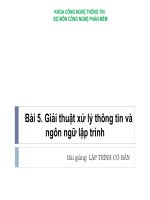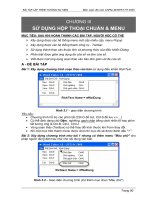Bài giảng Computer Organization and Architecture: Chapter 3
Bạn đang xem bản rút gọn của tài liệu. Xem và tải ngay bản đầy đủ của tài liệu tại đây (524.35 KB, 54 trang )
William Stallings
Computer Organization
and Architecture
6th Edition
Chapter 3
System Buses
Program Concept
• Hardwired systems are inflexible
• General purpose hardware can do different
tasks, given correct control signals
• Instead of rewiring, supply a new set of control
signals
What is a program?
• A sequence of steps
• For each step, an arithmetic or logical operation
is done
• For each operation, a different set of control
signals is needed
Function of Control Unit
• For each operation a unique code is provided
—e.g. ADD, MOVE
• A hardware segment accepts the code and
issues the control signals
• We have a computer!
Components
• The Control Unit and the Arithmetic and Logic
Unit constitute the Central Processing Unit
• Data and instructions need to get into the
system and results out
—Input/output
• Temporary storage of code and results is
needed
—Main memory
Computer Components:
Top Level View
Instruction Cycle
• Two steps:
—Fetch
—Execute
Fetch Cycle
• Program Counter (PC) holds address of next
instruction to fetch
• Processor fetches instruction from memory
location pointed to by PC
• Increment PC
—Unless told otherwise
• Instruction loaded into Instruction Register (IR)
• Processor interprets instruction and performs
required actions
Execute Cycle
• Processormemory
—data transfer between CPU and main memory
• Processor I/O
—Data transfer between CPU and I/O module
• Data processing
—Some arithmetic or logical operation on data
• Control
—Alteration of sequence of operations
—e.g. jump
• Combination of above
Example of Program Execution
Instruction Cycle State Diagram
Interrupts
• Mechanism by which other modules (e.g. I/O) may
interrupt normal sequence of processing
• Program
— e.g. overflow, division by zero
• Timer
— Generated by internal processor timer
— Used in preemptive multitasking
• I/O
— from I/O controller
• Hardware failure
— e.g. memory parity error
Program Flow Control
Interrupt Cycle
• Added to instruction cycle
• Processor checks for interrupt
— Indicated by an interrupt signal
• If no interrupt, fetch next instruction
• If interrupt pending:
— Suspend execution of current program
— Save context
— Set PC to start address of interrupt handler routine
— Process interrupt
— Restore context and continue interrupted program
Transfer of Control via Interrupts
Instruction Cycle with Interrupts
Program Timing
Short I/O Wait
Program Timing
Long I/O Wait
Instruction Cycle (with Interrupts) - State Diagram
Multiple Interrupts
• Disable interrupts
—Processor will ignore further interrupts whilst
processing one interrupt
—Interrupts remain pending and are checked after first
interrupt has been processed
—Interrupts handled in sequence as they occur
• Define priorities
—Low priority interrupts can be interrupted by higher
priority interrupts
—When higher priority interrupt has been processed,
processor returns to previous interrupt
Multiple Interrupts - Sequential
Multiple Interrupts – Nested
Time Sequence of Multiple Interrupts
Connecting
• All the units must be connected
• Different type of connection for different type of
unit
—Memory
—Input/Output
—CPU
Computer Modules









